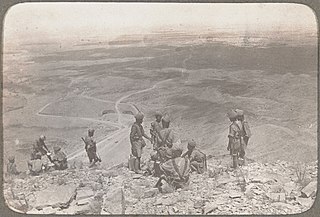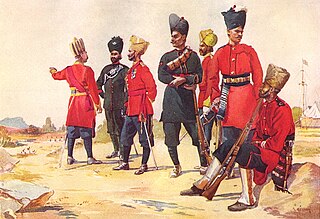 W
WThe 13th Rajputs was an infantry regiment of the Bengal Army, and later of the British Indian Army. They could trace their origins to the Shekhawati Regiment raised in 1835, as part of the Jaipur contingent of the Honourable East India Company and were taken into the Company's service as a local battalion 8 years later. They fought in the Battle of Aliwal in the First Anglo-Sikh War. Remaining loyal during the Indian Rebellion of 1857, they were taken into the Bengal Army as the 13th Bengal Native Infantry in 1861. There followed a number of different name changes the 13th (Shekhawati) Bengal Native Infantry 1884–1897, the 13th (Shekhawati) Rajput Regiment of Bengal Infantry 1897–1901, the 13th (Shekhawati) Rajput Infantry 1901–1903. Then finally in 1903, after the Kitchener reforms of the Indian Army the 13th Rajputs . During World War I they were part of the Imperial Service Infantry Brigade assigned to the Indian Expeditionary Force B that was sent to British East Africa. They fought at the Battle of Tanga.
 W
WThe 23rd Sikh Pioneers were a regiment of the British Indian Army. They could trace their origins to 1857, when they were known as the 15th (Pioneer) Regiment of Punjab Infantry. The regiment recruited exclusively from the Mazhabi Sikh community of Punjab province. Despite being "pioneers" by name, the regiment functioned as a Sikh infantry regiment specially trained as assault pioneers.
 W
WThe 24th Hazara Mountain Battery was an artillery battery of the British Indian Army. The battery was raised in 1851, at Haripur in order to help defend the Hazara District of the North West Frontier. The 4th soon saw action in numerous small campaigns on the North West Frontier. In 1878, the 4th took part in the Second Afghan War at the Battle of Ali Masjid, and later took part in the Siege of the Sherpur Cantonment, where it remained as part of the garrison when the rest of the force marched on Kandahar. In 1885, the Battery took part in the Second Burmese War. It was at Hunza during the campaign in 1891. In 1895, the Battery was back fighting on the Frontier as part of the Chitral Expedition.To honour the visit of the Prince and Princess of Wales to Indian they took part in the Rawalpindi Parade 1905. During World War I, the 4th left India in 1917, for East Africa where it would remain until the Armistice. Between the wars, the Battery saw service in the Third Afghan War of 1919, the Afridi and Red Shirt Rebellion (1930–1), the Mohmand and Bajaur Operations (1933), and operations against the Fakir of Ipi in the Waziristan campaign 1936–1939. It was deployed to Singapore at the opening of World War II, and entered Japanese captivity with the rest of the garrison.
 W
WThe 61st Pioneers were an infantry regiment of the British Indian Army. They could trace their origins to 1758, when they were raised as the 1st Battalion Coast Sepoys.
 W
WThe 73rd Carnatic Infantry was an infantry regiment originally raised in 1776 as the 13th Carnatic Battalion as part of the Presidency of Madras Army which was itself part of the Honourable East India Company Army. The presidency armies, like the presidencies themselves, belonged to the East India Company until the Government of India Act 1858 transferred all three presidencies to the direct authority of the British Crown. In 1903 all three presidency armies were merged into the British Indian Army. The unit was transferred to the Indian Army upon Indian Independence.
 W
WThe 107th Pioneers were an infantry regiment of the British Indian Army. Their origin can be traced back to 1788, when they were raised as the 4th Battalion, Bombay Sepoys.
 W
WThe 122nd Rajputana Infantry were an infantry regiment of the British Indian Army. The regiment traces their origins to 1818, when they were raised as the 2nd Battalion, 11th Regiment of Bombay Native Infantry.